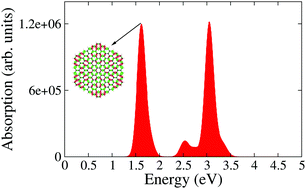Optical properties of pyridine adsorbed polycyclic aromatic hydrocarbons using quantum chemical calculations†
Abstract
Polycyclic aromatic hydrocarbons (PAHs), the molecular version of graphene, having edges saturated with hydrogen atoms, have recently emerged as a novel nanoplasmonic material. In this work, we investigate the optical properties of pristine and pyridine adsorbed circular and triangular PAHs. We base our calculations on computationally efficient first-principles time-dependent density-functional theory (TD-DFT) calculations. We find substantial changes in the optical absorption spectra induced by the presence of the pyridine molecule. In addition, with the help of electron difference density (EDD) maps, we demonstrate a strong optical interaction between PAHs and pyridine molecules. The main effect of pyridine adsorption is to split the plasmon band and to redistribute the optical absorption in a wider energy range. We believe that our findings can help in the design of novel plasmonic devices having PAHs as basic building blocks.



 Please wait while we load your content...
Please wait while we load your content...